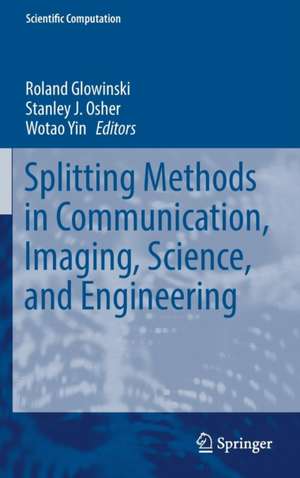Splitting Methods in Communication, Imaging, Science, and Engineering: Scientific Computation
Editat de Roland Glowinski, Stanley J. Osher, Wotao Yinen Limba Engleză Hardback – 13 ian 2017
| Toate formatele și edițiile | Preț | Express |
|---|---|---|
| Paperback (1) | 1114.31 lei 6-8 săpt. | |
| Springer International Publishing – 7 iul 2018 | 1114.31 lei 6-8 săpt. | |
| Hardback (1) | 1120.85 lei 6-8 săpt. | |
| Springer International Publishing – 13 ian 2017 | 1120.85 lei 6-8 săpt. |
Din seria Scientific Computation
- 18%
 Preț: 1003.81 lei
Preț: 1003.81 lei - 18%
 Preț: 730.76 lei
Preț: 730.76 lei - 18%
 Preț: 874.72 lei
Preț: 874.72 lei - 18%
 Preț: 1089.78 lei
Preț: 1089.78 lei -
 Preț: 381.48 lei
Preț: 381.48 lei - 20%
 Preț: 902.00 lei
Preț: 902.00 lei -
 Preț: 394.15 lei
Preț: 394.15 lei -
 Preț: 380.13 lei
Preț: 380.13 lei - 15%
 Preț: 643.60 lei
Preț: 643.60 lei -
 Preț: 373.87 lei
Preț: 373.87 lei - 18%
 Preț: 1092.59 lei
Preț: 1092.59 lei -
 Preț: 445.03 lei
Preț: 445.03 lei -
 Preț: 382.81 lei
Preț: 382.81 lei - 18%
 Preț: 934.01 lei
Preț: 934.01 lei - 15%
 Preț: 638.28 lei
Preț: 638.28 lei - 15%
 Preț: 585.83 lei
Preț: 585.83 lei - 18%
 Preț: 926.72 lei
Preț: 926.72 lei - 15%
 Preț: 496.69 lei
Preț: 496.69 lei -
 Preț: 383.18 lei
Preț: 383.18 lei - 15%
 Preț: 642.00 lei
Preț: 642.00 lei - 18%
 Preț: 941.29 lei
Preț: 941.29 lei - 15%
 Preț: 642.97 lei
Preț: 642.97 lei - 15%
 Preț: 633.14 lei
Preț: 633.14 lei - 15%
 Preț: 638.46 lei
Preț: 638.46 lei -
 Preț: 381.63 lei
Preț: 381.63 lei - 18%
 Preț: 942.21 lei
Preț: 942.21 lei - 18%
 Preț: 1110.45 lei
Preț: 1110.45 lei - 18%
 Preț: 951.24 lei
Preț: 951.24 lei - 15%
 Preț: 688.94 lei
Preț: 688.94 lei -
 Preț: 394.32 lei
Preț: 394.32 lei - 15%
 Preț: 587.93 lei
Preț: 587.93 lei -
 Preț: 379.18 lei
Preț: 379.18 lei -
 Preț: 388.27 lei
Preț: 388.27 lei -
 Preț: 378.64 lei
Preț: 378.64 lei - 18%
 Preț: 1087.95 lei
Preț: 1087.95 lei - 15%
 Preț: 495.69 lei
Preț: 495.69 lei - 15%
 Preț: 586.33 lei
Preț: 586.33 lei - 15%
 Preț: 642.97 lei
Preț: 642.97 lei
Preț: 1120.85 lei
Preț vechi: 1366.89 lei
-18% Nou
Puncte Express: 1681
Preț estimativ în valută:
214.61€ • 223.47$ • 178.06£
214.61€ • 223.47$ • 178.06£
Carte tipărită la comandă
Livrare economică 14-28 februarie
Preluare comenzi: 021 569.72.76
Specificații
ISBN-13: 9783319415871
ISBN-10: 3319415875
Pagini: 777
Ilustrații: XVIII, 820 p. 194 illus., 111 illus. in color.
Dimensiuni: 155 x 235 x 44 mm
Greutate: 1.34 kg
Ediția:1st ed. 2016
Editura: Springer International Publishing
Colecția Springer
Seria Scientific Computation
Locul publicării:Cham, Switzerland
ISBN-10: 3319415875
Pagini: 777
Ilustrații: XVIII, 820 p. 194 illus., 111 illus. in color.
Dimensiuni: 155 x 235 x 44 mm
Greutate: 1.34 kg
Ediția:1st ed. 2016
Editura: Springer International Publishing
Colecția Springer
Seria Scientific Computation
Locul publicării:Cham, Switzerland
Cuprins
Introduction.- Some Facts about Operator-Splitting and Alternating Direction Methods.- Operator Splitting.- Convergence Rate Analysis of Several Splitting Schemes.- Self Equivalence of the Alternating Direction Method of Multipliers.- Application of the Strictly Contractive Peaceman-Rachford Splitting Method to Multi-block Separable Convex Programming.- Nonconvex Sparse Regularization and Splitting Algorithms.- ADMM and Non-convex Variational Problems.- Operator Splitting Methods in Compressive Sensing and Sparse Approximation.- First Order Algorithms in Variational Image Processing.- A Parameter Free ADI-like Method for the Numerical Solution of Large Scale Lyapunov Equations.- Splitting Enables Overcoming the Curse of Dimensionality.- ADMM Algorithmic Regularization Paths for Sparse Statistical Machine Learning.- Decentralized Learning for Wireless Communications and Networking.- Splitting Methods for SPDEs: From Robustness to Financial Engineering, Optimal Control and Nonlinear Filtering.- Application of Operator Splitting Methods in Finance.- A Numerical Method to Solve Multi-marginal Optimal Transport Problems with Coulomb Cost.- Robust Split-step Fourier Methods for Simulating the Propagation of Ultra-short Pulses in Single- and Two-mode Optical Communication Fibers.- Operator Splitting Methods with Error Estimator and Adaptive Time-stepping: Application to the Simulation of Combustion Phenomena.- Operator Splitting Algorithms for Free Surface Flows: Application to Extrusion Processes.- An Operator Splitting Approach to the Solution of Fluid-structure Interaction Problems with Hemodynamics.- On Circular cluster Formation in a Rotating Suspension of Non-Brownian Settling Particles in a Fully Filled Circular Cylinder: An Operator Splitting Approach to the Numerical Simulation.
Notă biografică
Roland Glowinski works in Computational Mechanics and Physics and more generally in areas involving the numerical solution of partial differential equations and inequalities. Stanley Osher is a Professor of Mathematics, Computer Science and Electrical Engineering at UCLA, and is an Associate Director of the NSF funded Institute for Pure and Applied Mathematics. Wotao Yin works in optimization theory, develops many fast algorithms for compressive sensing, image processing, medical imaging, wireless networking, etc.
Textul de pe ultima copertă
This book is about computational methods based on operator splitting. It consists of twenty-three chapters written by recognized splitting method contributors and practitioners, and covers a vast spectrum of topics and application areas, including computational mechanics, computational physics, image processing, wireless communication, nonlinear optics, and finance. Therefore, the book presents very versatile aspects of splitting methods and their applications, motivating the cross-fertilization of ideas.
Caracteristici
No other book on splitting methods published in the last 10 years Includes applications that cover a wide variety of scientific areas Editors and authors include top international researchers in multiple areas Includes supplementary material: sn.pub/extras













